|

|
|
| |
|
China Oil Painting Direct
|
|
100% hand painted, 100%
cotton canvas,
100% money back if not satisfaction.
|
|
|
|
ART WORKS
INDEX
A B C D E F G H I J K L M N O P Q R S T U V W X Y Z
|
|
ARTISTS
INDEX
A B C D E F G H I J K L M N O P Q R S T U V W X Y Z
|
|
|
|
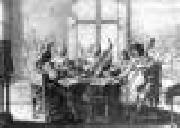 |
BOSSE, Abraham 
|
|
French Baroque Era Engraver, 1602-1676
Roughly 1600 etchings are attributed to him, with subjects including: daily life , religion, literature , history, fashion[8], technology, and science. Most of his output was illustrations for books, but many were also sold separately. His style grows from Dutch and Flemish art, but is given a strongly French flavour. Many of his images give fascinating and informative detail about middle and upper-class daily life in the period, although they must be treated with care as historical evidence. His combination of very carefully depicted grand interiors with relatively trivial domestic subjects was original and highly influential on French art, and also abroad ?? William Hogarth's engravings are, among other things, a parody of the style. Most of his images are perhaps best regarded as illustrations rather than art.
Watercolour of a ball by Abraham Bosse, a similar subject to many of his most famous etchingsHe was apprenticed in Paris about 1620 to the Antwerp-born engraver Melchior Tavernier (1564?C1641), who was also an important publisher. His first etchings date to 1622, and are influenced by Jacques Bellange. Following a meeting in Paris about 1630, he became a follower of Jacques Callot, whose technical innovations in etching he popularised in a famous and much translated Manual of Etching(1645), the first to be published. He took Callot's highly detailed small images to a larger size, and a wider range of subject matter.
Unlike Callot, his declared aim, in which he largely succeeded, was to make etchings look like engravings, to which end he sacrificed willingly the freedom of the etched line, whilst certainly exploiting to the full the speed of the technique. Like most etchers, he frequently used engraving on a plate in addition to etching, but produced no pure engravings.
|
|
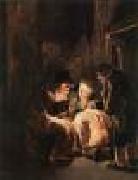 |
BOTH, Andries 
|
|
Dutch Baroque Era Painter, ca.1612-1641
Andries Both (1612/1613, Utrecht - March 23, 1642, Venice) Dutch genre painter, one of the bamboccianti, and brother of Jan Dirksz Both.
Both was the son of a glass painter, and studied under Abraham Bloemaert. According to Joachim von Sandrart, Andries and his brother Jan cooperated on the paintings, with Jan painting the landscapes and Andries the figures, though this view has been revised in the 20th century. Andries stayed in Rouen in 1633, and he traveled on to Rome, where is documented from 1635 to 1641. He first shared a studio with a fellow painter from Utrecht, Jan van Causteren. In 1638 his brother joined him, living on the Via Vittoria in the parish of San Lorenzo in Lucina and perhaps both joining the Accademia di San Luca and the group of painters led by Pieter van Laer. In 1641 the brothers traveled back to Holland, but Andries met his death in Venice on the way, drowning in a canal as he was returning from some festivities.
|
|
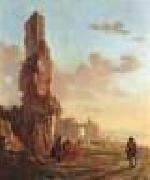 |
BOTH, Jan 
|
|
Dutch painter (b. ca. 1618, Utrecht, d. 1652, Utrecht
Brother of Andries Both. He was one of the foremost painters among the second generation of DUTCH ITALIANATES. While working in Italy he specialized in genre scenes; however, on his return to the Netherlands he concentrated on wooded landscapes bathed in a golden light that illuminates the highly detailed foliage and trees. These realistic landscapes represent his most original contribution to Dutch painting and were much imitated by his contemporaries and by later artists.
|
|
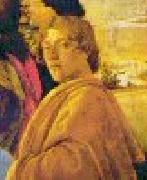 |
BOTTICELLI, Sandro 
|
|
Italian Early Renaissance Painter, 1445-1510
Alessandro di Mariano di Vanni Filipepi, better known as Sandro Botticelli or Il Botticello ("The Little Barrel"; March 1, 1445 ?C May 17, 1510) was an Italian painter of the Florentine school during the Early Renaissance (Quattrocento). Less than a hundred years later, this movement, under the patronage of Lorenzo de' Medici, was characterized by Giorgio Vasari as a "golden age", a thought, suitably enough, he expressed at the head of his Vita of Botticelli. His posthumous reputation suffered until the late 19th century; since then his work has been seen to represent the linear grace of Early Renaissance painting, and The Birth of Venus and Primavera rank now among the most familiar masterpieces of Florentine art.
Details of Botticelli's life are sparse, but we know that he became an apprentice when he was about fourteen years old, which would indicate that he received a fuller education than did other Renaissance artists. Vasari reported that he was initially trained as a goldsmith by his brother Antonio. Probably by 1462 he was apprenticed to Fra Filippo Lippi; many of his early works have been attributed to the elder master, and attributions continue to be uncertain. Influenced also by the monumentality of Masaccio's painting, it was from Lippi that Botticelli learned a more intimate and detailed manner. As recently discovered, during this time, Botticelli could have traveled to Hungary, participating in the creation of a fresco in Esztergom, ordered in the workshop of Fra Filippo Lippi by Vitez J??nos, then archbishop of Hungary.
By 1470 Botticelli had his own workshop. Even at this early date his work was characterized by a conception of the figure as if seen in low relief, drawn with clear contours, and minimizing strong contrasts of light and shadow which would indicate fully modeled forms.
|
|
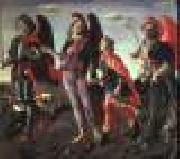 |
BOTTICINI, Francesco 
|
|
Italian Early Renaissance Painter, ca.1446-1498
Francesco di Giovanni Botticini (1446 ?C July 22, 1498) was an Italian Early Renaissance painter. He studied under Cosimo Rosselli and Andrea del Verrocchio. He was born in Florence in 1446 and is mostly remembered for his painting entitled "Assumption of the Virgin"; he died in 1498 (some sources say 1497). He established his own workshop after a brief period as Neri di Bicci's assistant; the shop was renowned for its decorative works, a few of which can be seen in the cloistered church of Empoli. Some of Botticini's works are said to be overshadowed by his Florentine contemporaries, such as Filippino Lippi and Botticelli, who often influenced Botticini's works.
|
|
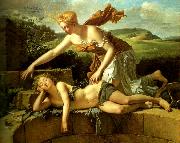 |
bouillon 
|
|
Pierre Bouillon (1776 - October 15, 1831) was a French painter and engraver. Born at Thiviers, he studied with the Academie-trained history painter Nicolas-Andre Monsiau. He was awarded the grand prize of the Institut de France in July, 1797. His drawing of Laocoön and His Sons was the basis of Charles Clement Bervic's celebrated print of the statue
|
|
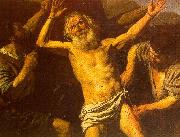 |
Boulogne, Valentin de 
|
|
French Baroque Era Painter, ca.1594-1632
|
|
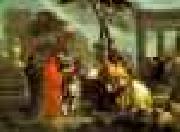 |
Bourdon, Sebastien 
|
|
French, 1616-1671.French painter. Bourdon was active in Rome (1634 C37), in Sweden (1652 C54) as Queen Christina's court portrait painter, and in Paris; he also worked in his native Montpellier, where he painted The Fall of Simon Magus for the cathedral. The Finding of Moses is in the National Gallery of Art, Washington, D.C.
|
|
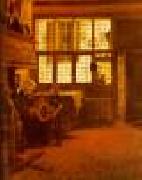 |
BOURSSE, Esaias 
|
|
Dutch Baroque Era Painter, 1631-1672
He was the youngest son of immigrants from Wallonia. His parents, Jacques Boursse and Anna des Forest, married in 1618 in Amsterdam. We know nothing more about the education of Esaias Boursse, other than the fact that he travelled to Italy in about 1650 to study the great Renaissance examples. No reminders of those examples is to be found in his work. In the past art historians have tried to place him among Rembrandt's pupils. There is no objective evidence at all to prove this though. Maybe this opinion has been inspired by the fact that the painters were neighbours in the Sint Antoniebreestraat in Amsterdam (nowadays called Jodenbreestraat, still housing the Rembrandt House Museum).
Boursse's financial position will not have been good, since in 1661 he sailed with the Verenigde Oostindische Compagnie, on the ship Amersfoort. It travelled to Ceylon (nowadays called Sri Lanka). Boursse drew the inhabitants, landscapes and city views, which have been preserved in an album which can be found in the print room of the Rijksmuseum Amsterdam. In 1663, the painter was back in Amsterdam.
In 1672, Boursse sailed with Verenigde Oostindische Compagnie again. The Amersfoort set sail on October 24 and on November 16 Boursse died at sea.
The life of Esaias Boursse is the story of a painter who could not earn a living by painting alone and therefore had to look for an alternative source of income. The fact that he was no exception is proven by the life stories of for example Jan Steen (who was also an innkeeper) and Johannes Vermeer (who was also an art dealer). A major difference though, is the fact that Steen and Vermeer had to feed and house a (large) family. Boursse seems to have remained unmarried and childless. Financially, Boursse's career was a success. He remains one of the highest paid artists in living memory.
|
|
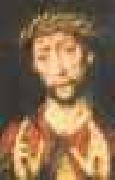 |
Bouts, Aelbrecht 
|
|
Flemish, approx. 1452-1549
|
|
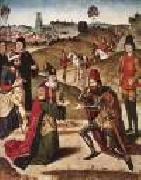 |
BOUTS, Dieric the Elder 
|
|
Flemish painter (b. ca. 1415, Haarlem, d. 1475, Leuven).
|
|
 |
BOUTS, Dieric the Younger 
|
|
b. ca. 1448, Leuven, d. 1491, Leuven
|
|
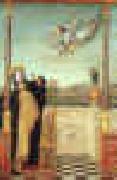 |
Braccesco, Carlo di 
|
|
Italian, active 1478-1501
|
|
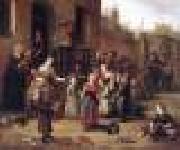 |
BRAKENBURG, Richard 
|
|
Dutch painter (b. 1650, Haarlem, d. 1702, Haarlem)
|
|
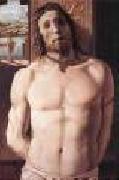 |
BRAMANTE 
|
|
Italian High Renaissance Architect and Painter, 1444-1514
In the first decade of the 16th century Donato Bramante was the chief architect in Rome, which had just replaced Florence as the artistic capital of Europe because the patronage of Pope Julius II (reigned 1503-1513) attracted all the leading Italian artists to that city. It is particularly the triumvirate of artists - Michelangelo the sculptor and painter, Raphael the painter, and Bramante the architect - who dominated this period, usually called the High Renaissance, and whose influence overwhelmed the following generations.
Donato di Pascuccio d'Antonio, called Bramante, was born in 1444 at Monte Asdruvaldo near Urbino. Nothing is known of the first 30 years of his life. During that period, however, the court of Federigo da Montefeltro at Urbino was a flourishing humanistic and cultural center, attended by artists such as Piero della Francesca, Melozzo da Forll, and Luciano Laurana, who probably influenced the young Bramante. The first notice of Bramante dates from 1477, when he decorated the facade of the Palazzo del Podestaat Bergamo with a frescoed frieze of philosophers.
|
|
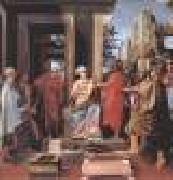 |
BRAMANTINO 
|
|
Italian High Renaissance Painter, ca.1460-1530
Leonaert/Leonard Bramer alias Nestelghat (Dec 24, 1596, Delft - buried Feb 10, 1674, Delft) was a Dutch painter, best known for probably being one of the teachers of Johannes Vermeer, although there is no similarity between their work. Bramer's dark and exotic style is unlike Vermeer's style. Bramer was primarily a genre and history painter, but also made some unique frescos, not very often found north of the Alps. Leonaert Bramer is one of the most intriguing personalities in seventeenth-century Dutch art. He was a talented and diligent draughtsman, evidently Catholic and a life long bachelor.
|
|
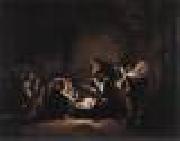 |
BRAMER, Leonaert 
|
|
Dutch Baroque Era Painter, 1596-1674
|
|
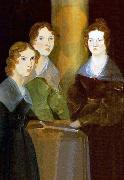 |
Branwell Bronte 
|
|
26 June 1817 - 24 September 1848) was a painter and poet, the only son of the Brontë family, and the brother of the writers Charlotte, Emily, and Anne.
Branwell Brontë was the fourth of six children and the only son of Patrick Brontë and his wife, Maria Branwell Brontë. He was born in Thornton, near Bradford, Yorkshire, and moved with his family to Haworth when his father was appointed to the perpetual curacy in 1821.
Of the four Brontë siblings who survived into adulthood, Branwell Brontë seems to have been regarded within the family as the most talented, at least during his childhood and youth. While four of his five sisters were sent to Cowan Bridge boarding school (resulting in the death of his two oldest sisters, Maria and Elizabeth, from tuberculosis), Branwell was kept at home to be privately educated by his father, who gave him a classical education suitable for admission to Oxford or Cambridge. Elizabeth Gaskell, biographer of his sister, Charlotte Bronte, says this of Branwell's schooling:
|
|
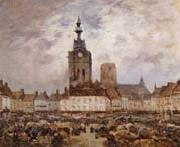 |
Braquaval Louis 
|
|
Esquermes 1854-Saimnt-Valery-sur-Somme 1919
|
|
|
|
Braud, Jean 
|
|
French Impressionist Painter, 1849-ca.1935
|
|
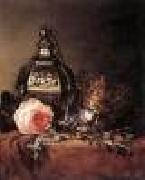 |
BRAY, Dirck 
|
|
Dutch painter, Haarlem school (active 1651-1678)
|
|
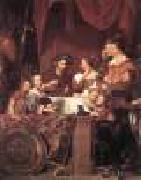 |
BRAY, Jan de 
|
|
Dutch Baroque Era Painter, ca.1627-1697
Painter, draughtsman and etcher, son of Salomon de Bray. He spent virtually the whole of his career in Haarlem, except for the period 1686-8, when he lived in Amsterdam. After training with his father, Jan began working as a portrait painter in Haarlem in 1650, an activity he continued for the next 40 years. Between 1667 and 1684 he served on the committee for the Haarlem Guild of St Luke, whose leading members he portrayed in a picture dated 1675 (Amsterdam, Rijksmus.) that includes a self-portrait (Jan is seen standing and drawing on the left). He married three times, in 1668, 1670 and 1672. His first two wives died a year after their marriage, his third two years afterwards, and in each case the death was followed by disputes over the inheritance. Jan's bankruptcy of 1689 may have been a result of one of the lawsuits.
|
|
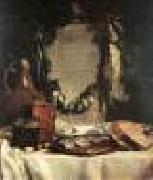 |
BRAY, Joseph de 
|
|
Dutch painter (d. 1664, Haarlem
|
|
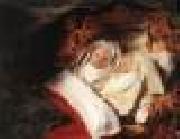 |
BRAY, Salomon de 
|
|
Dutch Baroque Era Painter, 1597-1664
De Bray established himself in Haarlem before 1617, where he is supposed to have been taught by Hendrick Goltzius and Cornelis van Haarlem, and where he married in 1625. He painted history paintings, portraits and landscapes. As a Catholic he probably also made altar pieces for clandestine churches. He cooperated in the decoration of Huis ten Bosch in The Hague. His works draw on the spirit of the Dutch classicism beginning at that time, and are comparable with those of Pieter de Grebber.
De Bray was also active as a designer of silverwork, as a poet, as an architect and as a town planner. As an architect, he was involved in the construction or expansion of Haarlem's City Hall, Zijlpoort, and St. Annakerk (Church of St. Anne), and Nijmegen's city orphanage. One of his poems was set to music by his friend the composer Cornelis Padbru??.
Salomon de Bray was the father of ten children, of whom three (including Jan de Bray) became artists. He probably died of the plague, as some of his children and was buried in the Sint-Bavokerk in Haarlem.
|
|
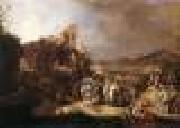 |
BREENBERGH, Bartholomeus 
|
|
Dutch Baroque Era Painter, ca.1598-1657
Dutch painter, draughtsman and etcher. He was one of at least eight children of a wealthy Protestant family in Deventer, where his father was the town pharmacist. After his father's death in 1607, the family left Deventer, probably moving to Hoorn. No artist then living in Hoorn could plausibly have been Breenbergh's teacher, and given the fact that his earliest works reveal the stylistic influence of the Pre-Rembrandtists, it is more probable that he was apprenticed in Amsterdam. In 1619 he was called upon to give testimony in Amsterdam: on this occasion his profession was listed as 'painter'. His oeuvre can be divided stylistically and iconographically into two distinct groups. He belonged to the first generation of DUTCH ITALIANATES, northern artists who travelled to Italy in the 1620s and were inspired by the light and poetry of the southern landscape. The work of this period consists of numerous Italianate landscape drawings and paintings.
|
|
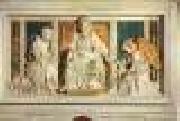 |
BREGNO, Andrea 
|
|
Italian Early Renaissance Sculptor and Architect, 1418-1503
Andrea Bregno was invited to move from Venice to Rome when the Venetian Paul II was elected Pope. During the pontificate of the Della Rovere Pope Sixtus IV he received many commissions and headed a large workshop, producing many wall tombs of cardinals and other figures of the papal curia with varying degrees of personal responsibility. He was famous among his contemporaries, and was compared to the Greek sculptor Polykleitos in the epitaph of his tomb in Santa Maria sopra Minerva. Raphael's father, Giovanni Santi, mentioned Bregno in the 1480s, in his biography of Federico da Montefeltro, duke of Urbino. Bregno often worked with Mino da Fiesole in Rome, and his refined Lombard manner was rendered more classical by the contact and by the example of Roman sculptures that were increasingly coming to light, of which Andrea Bregno was an early collector: a certain "Prospettivo Milanese", writing in 1499-1500 refers to a torso in the collection of a "Maestro Andrea" that seems to have been the Belvedere Torso.
He moved in humanist circles and was an esteemed friend of the humanist in Sixtus' circle, Bartolomeo Platina, the librarian of the Vatican Library. Bregno played a significant role in the standardization of an authentically classicizing style of epigraphy, in the inscriptions that accompany his tombs. In the Sistine Chapel he collaborated with Mino da Fiesole and Giovanni Dalmata to produce the little cantoria or choristers' gallery set into the wall, with its own coffered ceiling and carved marble balusters, and the marble screen.
|
|
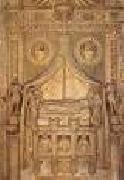 |
BREGNO, Antonio 
|
|
Italian Early Renaissance Sculptor and Architect, active ca.1425-1457
|
|
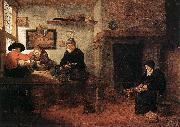 |
BREKELENKAM, Quiringh van 
|
|
Dutch painter (active c. 1647-1669 in Leiden)
Dutch painter. He probably trained in Leiden, possibly under Gerrit Dou. In 1648, with several other painters, he founded the Guild of St Luke in Leiden. He married for the first time in 1648 and again in 1656, a year after his first wife's death. In 1649 his sister Aeltge married the painter Johannes Oudenrogge (1622-53), and the couple soon moved to Haarlem while the Brekelenkam family remained in Leiden. About 1656 Brekelenkam apparently acquired a licence to sell beer and brandy, perhaps because his income as a painter was insufficient to support his large family (six children from his first marriage and three from his second). He continued to be active as an artist and paid his guild dues fairly regularly. The last dues were paid in 1667, and his last dated painting, the Portrait of a Man Aged 33, is from 1669.
|
|
 |
BRESCIANINO, Andrea del 
|
|
Italian painter (b. ca. 1487, Ferrara, d. after 1524, Ferrara)
|
|
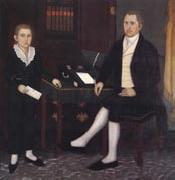 |
Brewster john 
|
|
American portrait Painter, 1766-1854
|
|
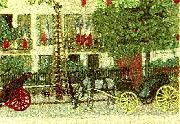 |
brianchon 
|
|
|
|
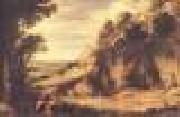 |
BRIL, Paul 
|
|
Flemish Baroque Era Painter, ca.1554-1626
Painter, printmaker and draughtsman, brother of Matthijs Bril. According to van Mander, Paul studied in Antwerp with Damiaan Wortelmans (1545-after 1588/9) before travelling to Rome, via Lyon, c. 1574, to join his brother, whom, according to Baglione, he assisted on Vatican commissions after 1576. However, no document places Paul in Rome before 1582, and in any case Matthijs was probably not there until c. 1575. Paul's first known independent works are monumental frescoes dating from the late 1580s. They include a dramatic rendering of Jonah and the Whale (1588) in the Scala Santa in the Vatican (based on a drawing by Matthijs; Paris, Louvre) and a series of landscape lunettes (c. 1589) in the Lateran Palace.
|
|
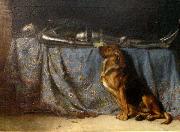 |
Briton Riviere 
|
|
(14 August 1840 C 1920) was an Irish artist born in London, England.
His father, William Riviere, was for some years drawing-master at Cheltenham College, and afterwards an art teacher at Oxford University. He was educated at Cheltenham College and at Oxford, where he took his degree in 1867. For his art training he was indebted almost entirely to his father, and early in life made for himself a place of importance among the artists of his time.
His first pictures appeared at the British Institution, and in 1857 he exhibited three works at the Royal Academy, but it was not until 1863 that he became a regular contributor to the Academy exhibitions. In that year he was represented by "The Eve of the Spanish Armada", and in 1864 by a "Romeo and Juliet". Subjects of this kind did not, however, attract him long, for in 1865 he began, with a picture of a "Sleeping Deer-hound", a series of paintings of animal-subjects which later occupied him almost exclusively.
|
|
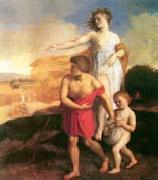 |
Brocky, Karoly 
|
|
1807-1855
|
|
 |
broderna von wrights 
|
|
Dessa ornitologer, forskare, naturvetenskapliga illustratörer och konstnärer var födda i Haminanlaks nära Kuopio i Finland.
I Stockholm i augusti 1828 påbörjade Magnus och Wilhelm von Wright bildverket Svenska Foglar, finansierat av greve Nils Bonde. Detta ornitologiska verk blev klart 1838 och ar en en samling pa178 litografier.
|
|
 |
Brodero Mathisen 
|
|
artist in 16th centry.
|
|
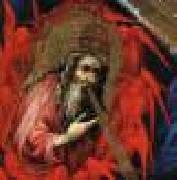 |
BROEDERLAM, Melchior 
|
|
Netherlandish Gothic Era Painter, ca.1355-1411
South Netherlandish painter. Broederlam's family, long-established in Ypres, provided three aldermen for the city and sided with the French Counts of Flanders against the Flemish populace. After a training that may have included contact with Jan Boudolf in Bruges before 1368 or Paris after 1370 and an extended visit to Italy, the artist became, by 1381, an official painter of the reigning count, Louis de M?le (reg. 1346-84), painting leather chairs, pennons and banners. On 13 May 1384, directly after Louis's death, he was appointed a valet de chambre to the count's heir, Philip the Bold, Duke of Burgundy.
|
|
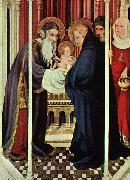 |
Broederlam, Melchoir 
|
|
Flemish, active 1381-1409
|
|
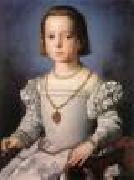 |
BRONZINO, Agnolo 
|
|
Italian Mannerist Painter, 1503-1572
Italian painter and poet. He dominated Florentine painting from the 1530s to the 1560s. He was court artist to Cosimo I de' Medici, and his sophisticated style and extraordinary technical ability were ideally suited to the needs and ideals of his ducal patron. He was a leading decorator, and his religious subjects and mythological scenes epitomize the grace of the high maniera style.
|
|
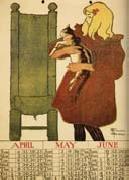 |
Brooklyn 
|
|
1866--1925
|
|
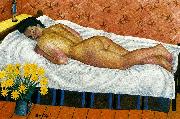 |
bror hjorth 
|
|
Bror Hjorth, född 22 april 1894 i Marma, död 21 maj 1968 i Uppsala, var en svensk konstnär.
Bror Hjorth var son till skogsvaktaren Emil Johanzon och Charlotta Johansdotter. Han är en av Sveriges mest kända skulptörer och målare. Han var lärare i teckning vid Konsthögskolan 1949 -- 1959, där han hade bland annat Kerstin Kjellberg-Jacobsson som elev. Han bosatte sig efter studietiden i Uppsala. Han uppförde där sitt ateljehus i Kåbo, Bror Hjorths Hus, som numera är museum. Bror Hjorth erhöll Sergelpriset 1955.
Under några år i början av 1930-talet drev Bror Hjorth tillsammans med Nils Möllerberg en skulpturskola i Stockholm.
Bror Hjorth ligger begravd på kyrkogården i Björklinge.
|
|
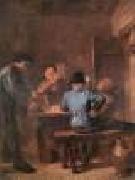 |
BROUWER, Adriaen 
|
|
Flemish Baroque Era Painter, ca.1605-1638
Adriaen Brouwer (1605, Oudenaarde - January 1638, Antwerp) was a Flemish genre painter active in Flanders and the Dutch Republic in the seventeenth century.
At a young age Brouwer, probably born as Adriaen de Brauwer, moved perhaps via Antwerp to Haarlem, where he became a student of Frans Hals alongside Adriaen van Ostade. He also was active in stage acting and poetry. He stayed in Haarlem and Amsterdam until 1631, when he moved back to Antwerp in the Spanish Netherlands. There, he became a member of the Guild of St. Luke in 1631 ?C 1632, as well as the rhetoricians's chamber De Violieren.
Tradition has it that Brouwer himself spent much time in the alehouses of Flanders and Holland. His works are typically detailed and small, and often adopt themes of debauchery, drunkenness and foolishness in order to explore human emotions, expressions and responses to pain, fear and the senses. The Bitter Tonic (illustrated right) is an example of the type of work that depicts such responses, in this case the sense of taste. His work was well liked, to the point that forgeries were sold in his own time. Both Rubens and Rembrandt owned a number of his works. Nevertheless, Brouwer appeared in financial trouble throughout his life.
He died at the early age of 32 in Antwerp, where he was first buried in a common grave, but, upon instigation of the members of the guild, was reburied on Feb 1, 1638 in the church of the Carmelites.
|
|
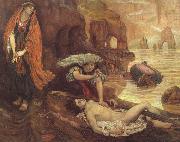 |
Brown, Ford Madox 
|
|
English Pre-Raphaelite Painter, 1821-1893
English painter and designer. The son of a retired ship's purser who had settled at Calais, Brown received an academic training under Albert Gregorius (1774-1853) at Bruges, under Pieter van Hanselaere (1786-1862) at Ghent and under Baron Gustaf Wappers at the Academie in Antwerp (1837-9). He moved to Paris in 1840, married the following year and studied independently of the ateliers,
|
|
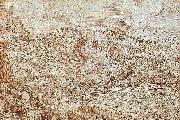 |
BRUEGEL, Pieter the Elder 
|
|
Flemish Northern Renaissance Painter, ca.1525-1569
(born c. 1525, probably Breda, duchy of Brabant ?? died Sept. 5/9, 1569, Brussels) Greatest Netherlandish painter of the 16th century. Not much is known of his early life, but in 1551 he set off for Italy, where he produced his earliest signed painting, Landscape with Christ and the Apostles at the Sea of Tiberias (c. 1553). Returning to Flanders in 1555, he achieved some fame with a series of satirical, moralizing prints in the style of Hiëronymus Bosch, commissioned by an Antwerp engraver. He is best known for his paintings of Netherlandish proverbs, seasonal landscapes, and realistic views of peasant life and folklore, but he also took a novel approach to religious subject matter, portraying biblical events in panoramic scenes, often viewed from above. He had many important patrons; most of his paintings were commissioned by collectors. In addition to many drawings and engravings, about 40 authenticated paintings from his enormous output have survived. His sons, Peter Brueghel the Younger and Jan, the Elder Brueghel (both of whom restored to the name the h their father had abandoned), and later imitators carried his style into the 18th century.
|
|
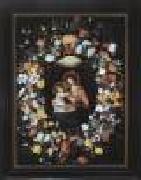 |
BRUEGHEL, Ambrosius 
|
|
Flemish painter (b. 1617, Antwerpen, d. 1675, Antwerpen).
Ambrosius Brueghel (Antwerp, 1617??9 February 1675) was a Flemish Baroque painter who specialized in landscapes and flower paintings. His work is similar to that of his half-brother, Jan Brueghel the Younger, and his nephew, Abraham Brueghel.[1] He was primarily active Antwerp, probably travelled to Italy around 1639, and was dean of Antwerp's Guild of St. Luke from 1653 to 1671.
|
|
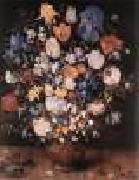 |
BRUEGHEL, Jan the Elder 
|
|
Flemish painter (bc1568, Bruxelles, d. 1625, Antwerpen).
|
|
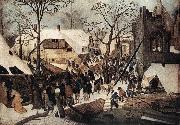 |
BRUEGHEL, Pieter the Younger 
|
|
Flemish painter (b. 1564, Bruxelles, d. 1638, Antwerp).
Pieter Brueghel the Younger was the oldest son of the famous sixteenth-century Netherlandish painter Pieter Brueghel the Elder (known as "Peasant Brueghel") and Mayken Coecke van Aelst. His father died in 1569, when Pieter the younger was only five years old. Then, following the death of his mother in 1578, Pieter, along with his brother Jan Brueghel the Elder ("Velvet Brueghel") and sister Marie, went to live with their grandmother Mayken Verhulst (widow of Pieter Coecke van Aelst). She was an artist in her own right, and according to Carel van Mander, possibly the first teacher of the two sons. The family moved to Antwerp sometime after 1578 and Pieter possibly entered the studio of the landscape painter Gillis van Coninxloo (1544-1607). In the 1584/1585 registers of Guild of Saint Luke, "Peeter Brugel" is listed as an independent master. On November 5, 1588 he married Elisabeth Goddelet, and the couple had seven children.
He painted landscapes, religious subjects and fantasy paintings. For this last category he often made use of fire and grotesque figures, leading to his nickname "Hell Brueghel".
Apart from these paintings of his own invention, Pieter Brueghel the Younger also copied the works his father had created by using a technique called pouncing. His genre paintings of peasants lack Pieter the Elder's subtlety and humanism, and emphasize the picturesque.
|
|
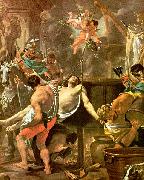 |
Brun, Charles Le 
|
|
French Baroque Era Painter, 1619-1690
French painter and designer. He dominated 17th-century French painting as no other artist; it was not until over a century later, during the predominance of Jacques-Louis David, that artistic authority was again so concentrated in one man. Under the protection of a succession of important political figures, including Chancellor Pierre S?guier, Cardinal Richelieu and Nicolas Fouquet, Le Brun created a series of masterpieces of history and religious painting. For Louis XIV and his chief minister Jean-Baptiste Colbert he executed his greatest work, the royal palace of Versailles: an almost perfect ensemble of architecture, decoration and landscape. After Colbert's death in 1683, he was no longer able to count on prestigious commissions
|
|
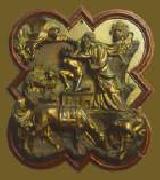 |
BRUNELLESCHI, Filippo 
|
|
Italian Early Renaissance Sculptor and Architect, 1377-1446
Filippo Brunelleschi (1377 ?C April 15, 1446) was one of the foremost architects and engineers of the Italian Renaissance. All of his principal works are in Florence, Italy. As explained by Antonio Manetti, who knew Brunelleschi and who wrote his biography, Brunelleschi "was granted such honors as to be buried in Santa Maria del Fiore, and with a marble bust, which they say was carved from life, and placed there in perpetual memory with such a splendid epitaph."
In 1401,Brunelleschi entered a competition to design a new set of bronze doors for the baptistery in Florence. Along with another young goldsmith, Lorenzo Ghiberti, he produced a gilded bronze panel, depicting the Sacrifice of Isaac. His entry made reference to a classical statue, known as the 'thorn puller', whilst Ghiberti used a naked torso for his figure of Isaac. In 1403, Ghiberti was announced the victor, largely because of his superior technical skill: his panel showed a more sophisticated knowledge of bronze-casting; it was completed in one single piece. Brunelleschi's piece, by contrast, was comprised of numerous pieces bolted to the back plate. Ghiberti went on to complete a second set of bronze doors for the baptistery, whose beauty Michelangelo extolled a hundred years later, saying "surely these must be the "Gates of Paradise."
|
|
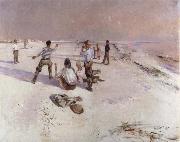 |
bruno liljefors 
|
|
Bruno Andreas Liljefors (1860-1939) was a Swedish artist, the most important and probably the most influential wildlife painter of the late nineteenth and early twentieth century.[1] He also drew some sequential picture stories, making him one of the early Swedish comic creators.
Liljefors is held in high esteem by painters of wildlife and is acknowledged as an influence, for example, by American wildlife artist Bob Kuhn.[1] All his life Liljefors was a hunter, and he often painted predator-prey action, the hunts engaged between fox and hare, sea eagle and eider, and goshawk and black grouse serving as prime examples.[1] However, he never exaggerated the ferocity of the predator or the pathos of the prey, and his pictures are devoid of sentimentality.
The influence of the Impressionists can be seen in his attention to the effects of environment and light, and later that of Art Nouveau in his Mallards, Evening of 1901, in which the pattern of the low sunlight on the water looks like leopardskin, hence the Swedish nickname Panterfällen.[1] Bruno was fascinated by the patterns to be found in nature, and he often made art out of the camouflage patterns of animals and birds. He particularly loved painting capercaillies against woodland, and his most successful painting of this subject is the largescale Capercaillie Lek, 1888, in which he captures the atmosphere of the forest at dawn. He was also influenced by Japanese art, for example in his Goldfinches of the late 1880s.[1]
During the last years of the nineteenth century, a brooding element entered his work, perhaps the result of turmoil in his private life, as he left his wife, Anna, and took up with her younger sister, Signe, and was often short of money.[1] This darker quality in his paintings gradually began to attract interest and he had paintings exhibited at the Paris Salon.
He amassed a collection of animals to act as his living models. Ernst Malmberg recalled:
The animals seemed to have an instinctive trust and actual attraction to him...There in his animal enclosure, we saw his inevitable power over its many residents??foxes, badgers, hares, squirrels, weasels, an eagle, eagle owl, hawk, capercaillie and black game.[1]
The greatness of Liljefors lay in his ability to show animals in their environment.[1] Sometimes he achieved this through hunting and observation of the living animal, and sometimes he used dead animals: for example his Hawk and Black Game, painted in the winter of 1883-4, was based on dead specimens, but he also used his memory of the flocks of black grouse in the meadows around a cottage he once lived in at Ehrentuna, near Uppsala. He wrote:
The hawk model??a young one??I killed myself. Everything was painted out of doors as was usually done in those days. It was a great deal of work trying to position the dead hawk and the grouse among the bushes that I bent in such a way as to make it seem lively, although the whole thing was in actuality a still life.[1]
|
|
|
|
|
|
|
|
|
| Wholesale China Oil Painting Wholesale Oil Painting China Xiamen Portrait Reproduction on canvas Chinese Oil Painting Wholesale USA Oil Painting |
|
|
|
|